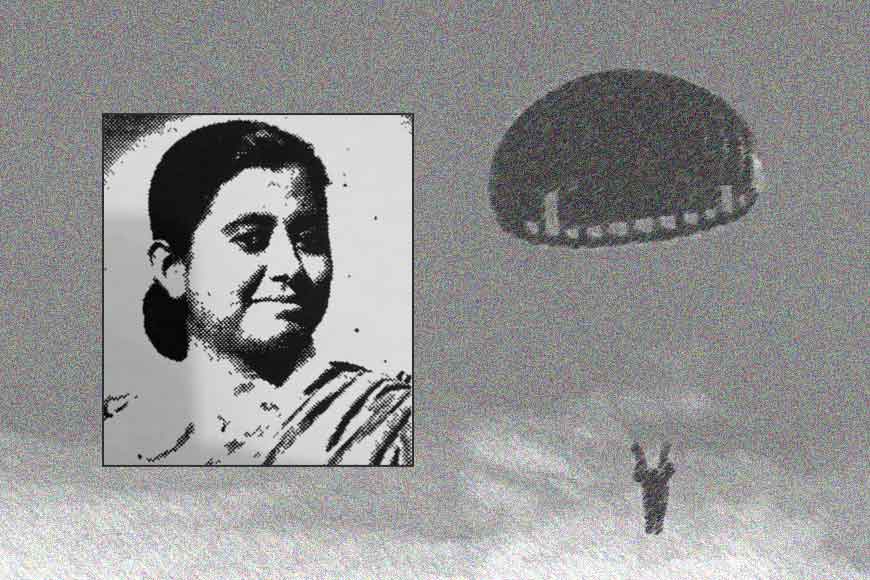Bengal's Gita Chandra, India’s first female paratrooper

This is a story that dates back to 1959. The date was July 17. A Dakota aircraft was flying mid-air in North India. The aircraft door was ajar and four paratroopers stood in a row, all set to take the plunge. The first three members were trainers and behind them stood the apprentice, all set to jump for the very first time from the airplane. A huge crowd had gathered underneath to watch the incident. And why not? After all, history was going to be created and all wanted to witness the daring act and be a part of the historic moment.
The decisive moment came. As soon as the signal came, the three instructors jumped out. The trainee paratrooper came forward and stood on the edge of the plane’s door and waited. As soon as the signal was given, the apprentice took the plunge. History was written and her name featured permanently as the first Indian female paratrooper. Seconds after she jumped, she felt a backward pull. She looked above and watched her parachute inflating like a huge colourful umbrella. The speed of her descent reduced and she glided slowly, looking below. Within 20 seconds, the land below was visible to her and within 40 seconds; she landed safely and gracefully on ground. The crowd cheered wildly as she touched the ground.
Gita was determined to succeed but her wish would have been thwarted midway if Air Marshal Subroto Mukherjee had not supported her wish and boosted her resolution. He was then operating as the first Indian Commander-in-Chief of the Indian Air Force. Gita was selected for the course. She joined the para-trooper school in May 1959.
Who was this brave girl? She was Gita Chandra, a Bengali lass who spent her childhood and teenage years in Rangpur. Her father, Harendra Chandra was a lecturer at Carmichael College. Gita was brilliant in academics and was also very outgoing and a keen sportsperson. She studied medicine and after completing her studies, she joined the Indian Air Force as a medical officer in November 1957. She was posted in West Bengal. In 1959, the Indian Air Force mooted a proposal for all medical professionals in the Air Force to get training in para-trooping. Accordingly, a circular was sent to all stations. No male doctor volunteered to accept the proposal for the training and signed on the circular, stating their objection. Gita, however, was made of tougher stuff and she jumped at the very first offer. Her colleagues prompted her to write “Not applicable” on the circular but Gita was offended by the suggestion. She promptly applied to participate in the programme. Her decision shocked all and sundry who believed para-trooping was a dangerous task and meant for burly soldiers alone. So, her detractors waited patiently for her quick retreat.
Gita was determined to succeed but her wish would have been thwarted midway if Air Marshal Subroto Mukherjee had not supported her wish and boosted her resolution. He was then operating as the first Indian Commander-in-Chief of the Indian Air Force. Gita was selected for the course. She joined the para-trooper school in May 1959. Her training began in North India and she was the only apprentice undergoing training in the school amid the scorching heat of the northern plains. For a month-and-a-half, she was required to sprint for five miles and then undergo physical training and free-hand exercises. After that, her para-trooping ground training was initiated. After she completed the training, it was time for her to take the test.
Gita Chandra, a Bengali lass who spent her childhood and teenage years in Rangpur. Her father, Harendra Chandra was a lecturer at Carmichael College. Gita was brilliant in academics and was also very outgoing and a keen sportsperson. She studied medicine and after completing her studies, she joined the Indian Air Force as a medical officer in November 1957.
July 17, 1959 was finalized and Gita Chandra showed her mettle and jumped from a flying Dakota aircraft. Mr V.K. Krishna Menon, the then Minister of Defence was also present at the site and witnessed the event with the general public. The crowd was ecstatic. This boosted Gita’s confidence as well. Within seven days of the event, Gita participated in her second para-trooping event. But this time, unfortunately, things did not go so smoothly as the earlier one. As she jumped out of the aircraft, her parachute got twisted and tangled in knots, and would not open or inflate the way it was meant to be. Gita knew she would have to think and act fast. Each second was precious. She remembered her instructors’ words and manipulated the parachute deftly to land safely on ground.
Gita had para-trooped seven times as part of the training and once at night as well. After she successfully completed the course, Air Marshal Mukherjee had personally honoured her with the para-trooper’s badge.
India’s first female paratrooper was a Bengali girl, Gita Chandra but it is a matter of shame that we have callously erased the brave lady’s name from the annals of history.










